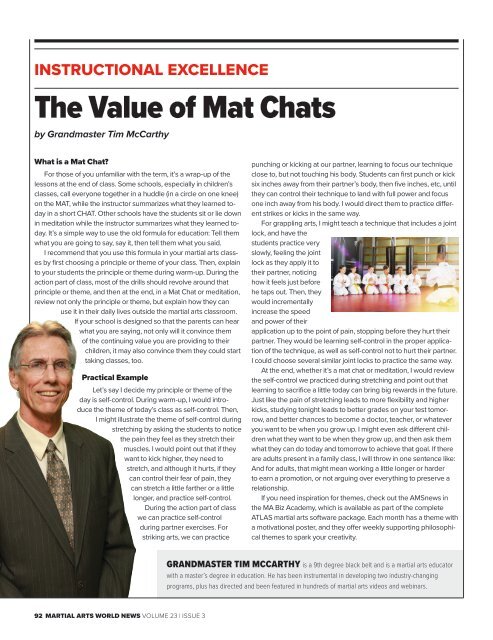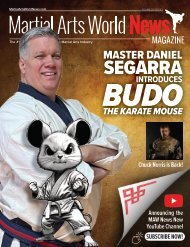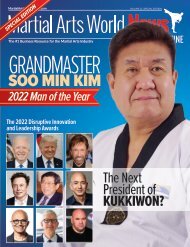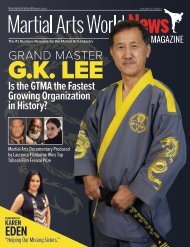Martial Arts World News Magazine - Volume 23 | Issue 3
The #1 Business Resource for the Martial Arts Industry
The #1 Business Resource for the Martial Arts Industry
You also want an ePaper? Increase the reach of your titles
YUMPU automatically turns print PDFs into web optimized ePapers that Google loves.
INSTRUCTIONAL EXCELLENCE<br />
The Value of Mat Chats<br />
by Grandmaster Tim McCarthy<br />
What is a Mat Chat?<br />
For those of you unfamiliar with the term, it’s a wrap-up of the<br />
lessons at the end of class. Some schools, especially in children’s<br />
classes, call everyone together in a huddle (in a circle on one knee)<br />
on the MAT, while the instructor summarizes what they learned today<br />
in a short CHAT. Other schools have the students sit or lie down<br />
in meditation while the instructor summarizes what they learned today.<br />
It’s a simple way to use the old formula for education: Tell them<br />
what you are going to say, say it, then tell them what you said.<br />
I recommend that you use this formula in your martial arts classes<br />
by first choosing a principle or theme of your class. Then, explain<br />
to your students the principle or theme during warm-up. During the<br />
action part of class, most of the drills should revolve around that<br />
principle or theme, and then at the end, in a Mat Chat or meditation,<br />
review not only the principle or theme, but explain how they can<br />
use it in their daily lives outside the martial arts classroom.<br />
If your school is designed so that the parents can hear<br />
what you are saying, not only will it convince them<br />
of the continuing value you are providing to their<br />
children, it may also convince them they could start<br />
taking classes, too.<br />
Practical Example<br />
Let’s say I decide my principle or theme of the<br />
day is self-control. During warm-up, I would introduce<br />
the theme of today’s class as self-control. Then,<br />
I might illustrate the theme of self-control during<br />
stretching by asking the students to notice<br />
the pain they feel as they stretch their<br />
muscles. I would point out that if they<br />
want to kick higher, they need to<br />
stretch, and although it hurts, if they<br />
can control their fear of pain, they<br />
can stretch a little farther or a little<br />
longer, and practice self-control.<br />
During the action part of class<br />
we can practice self-control<br />
during partner exercises. For<br />
striking arts, we can practice<br />
punching or kicking at our partner, learning to focus our technique<br />
close to, but not touching his body. Students can first punch or kick<br />
six inches away from their partner’s body, then five inches, etc, until<br />
they can control their technique to land with full power and focus<br />
one inch away from his body. I would direct them to practice different<br />
strikes or kicks in the same way.<br />
For grappling arts, I might teach a technique that includes a joint<br />
lock, and have the<br />
students practice very<br />
slowly, feeling the joint<br />
lock as they apply it to<br />
their partner, noticing<br />
how it feels just before<br />
he taps out. Then, they<br />
would incrementally<br />
increase the speed<br />
and power of their<br />
application up to the point of pain, stopping before they hurt their<br />
partner. They would be learning self-control in the proper application<br />
of the technique, as well as self-control not to hurt their partner.<br />
I could choose several similar joint locks to practice the same way.<br />
At the end, whether it’s a mat chat or meditation, I would review<br />
the self-control we practiced during stretching and point out that<br />
learning to sacrifice a little today can bring big rewards in the future.<br />
Just like the pain of stretching leads to more flexibility and higher<br />
kicks, studying tonight leads to better grades on your test tomorrow,<br />
and better chances to become a doctor, teacher, or whatever<br />
you want to be when you grow up. I might even ask different children<br />
what they want to be when they grow up, and then ask them<br />
what they can do today and tomorrow to achieve that goal. If there<br />
are adults present in a family class, I will throw in one sentence like:<br />
And for adults, that might mean working a little longer or harder<br />
to earn a promotion, or not arguing over everything to preserve a<br />
relationship.<br />
If you need inspiration for themes, check out the AMSnews in<br />
the MA Biz Academy, which is available as part of the complete<br />
ATLAS martial arts software package. Each month has a theme with<br />
a motivational poster, and they offer weekly supporting philosophical<br />
themes to spark your creativity.<br />
GRANDMASTER TIM MCCARTHY is a 9th degree black belt and is a martial arts educator<br />
with a master’s degree in education. He has been instrumental in developing two industry-changing<br />
programs, plus has directed and been featured in hundreds of martial arts videos and webinars.<br />
92 MARTIAL ARTS WORLD NEWS VOLUME <strong>23</strong> | ISSUE 3
















